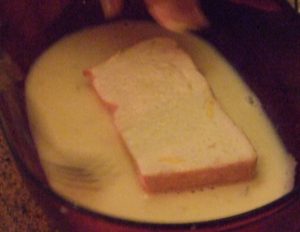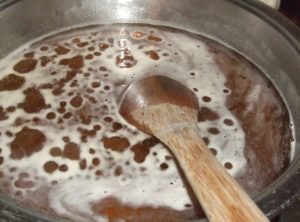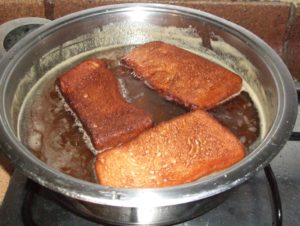Sweet treats in Spain: Torrijas at Easter
Semana Santa, or Holy week, is a week of processions and traditional food leading up to Easter in Spain. If you have never seen a Semana Santa procession, it’s quite something. In the larger cities, people come out in their droves to watch the religious effigies passing by accompanied by sombre music. The procession goes on for hours at a time and consists of a paso – large wooden statues of Jesus and Mary on a float along with other representations of the Christian portrayal of Easter. It’s impressive, not only because of the decoration, fresh flowers and the robes and candles of the penitents that follow the effigies, but also because the representation is carried on the shoulders of people, generally men, who have been in training for weeks.
In the villages, it’s often a challenge as they move the ‘paso’ around tight corners and along narrow streets. Probably, the one that impressed me the most was in the smaller town of Salobreña in the province of Granada. The effect of the colours against the background of the white village was breath taking. This was also the first time I experienced La Saeta – a religious song sung a capella in which the singer shows his devotion to the statue in the procession. A band playing through the streets is always enough to make me want to watch any procession, but the saeta was something else. A powerful voice reaching out across the square was the only sound you could hear amongst the crowd.
Sweet Treats
Semana Santa is also a week for eating and dining out with friends and family. While there are various traditional sweet dishes during Holy Week, one of my favourites is Torrijas – a type of sweet French toast.
While the recipe varies slightly all over Spain, typically Torrijas are made from bread left to soak in milk or wine, dipped in egg, fried and covered in a sweet syrup.
Torrijas are widely available in Spanish cake shops during Lent and are often made at home too. It’s a simple process to make these delicious treats. You’ll find the Spanish either eating them for breakfast or with an afternoon coffee.
How to make Torrijas
I’ve been told the trick is to use day old bread and whole milk. In Chipiona the local sweet wine Moscatel is often used to soak the bread rather than milk. The Torrijas are fried and then bathed in syrup producing a rich, sweet and filling treat. While some people make the syrup with hot water and sugar, Benjamin’s mum, Carmen, uses hot water and honey with a pinch of salt creating a sweet syrup called meloja. The quantity of each ingredient depends on the amount you wish to prepare.
- Soak the bread in milk with a pinch of salt or wine for at least 30 minutes
- Beat some eggs with milk
- Dip the bread soaked in milk or wine into the egg mixture

- Fry the bread in hot oil

- Remove each slice carefully from the frying pan and place on kitchen paper to cool and drain off any excess oil.
The syrup
To prepare the syrup – heat a pan of water, add plenty of honey and a pinch of salt. Once the mixture has reached boiling point, lower the heat and keep stirring until the syrup thickens. 
Once the bread has cooled, you can dip each slice into the hot syrup using a pair of tongs. It’s  important that the bread has cooled otherwise it will disintegrate in the syrup. Put the bread slices onto a plate or a container and pour the rest of the syrup over the top so that the slices remain moist. Once they have cooled, they are ready to eat and will last for a few days if kept in an airtight container. I don’t know about other Spanish families, but here the Torrijas don’t usually make it to the air-tight container however many Carmen makes!
important that the bread has cooled otherwise it will disintegrate in the syrup. Put the bread slices onto a plate or a container and pour the rest of the syrup over the top so that the slices remain moist. Once they have cooled, they are ready to eat and will last for a few days if kept in an airtight container. I don’t know about other Spanish families, but here the Torrijas don’t usually make it to the air-tight container however many Carmen makes!
While this might sound overly sweet, the bread gives it a savoury touch. I’m not very sweet-toothed but I have to admit I love home-made Torrijas.
Variations on the recipe include adding cinnamon to the milk when soaking the bread and lemon peel to the oil when frying.
If you are looking for an energy boost Torrijas are ideal. Apparently, before they became associated with Semana Santa they were given to women in labour to recover their strength after giving birth.
If you have enjoyed reading this or make your own Torrijas, I’d love to hear about it in the comment box below.
One thought on “Sweet treats in Spain: Torrijas at Easter”